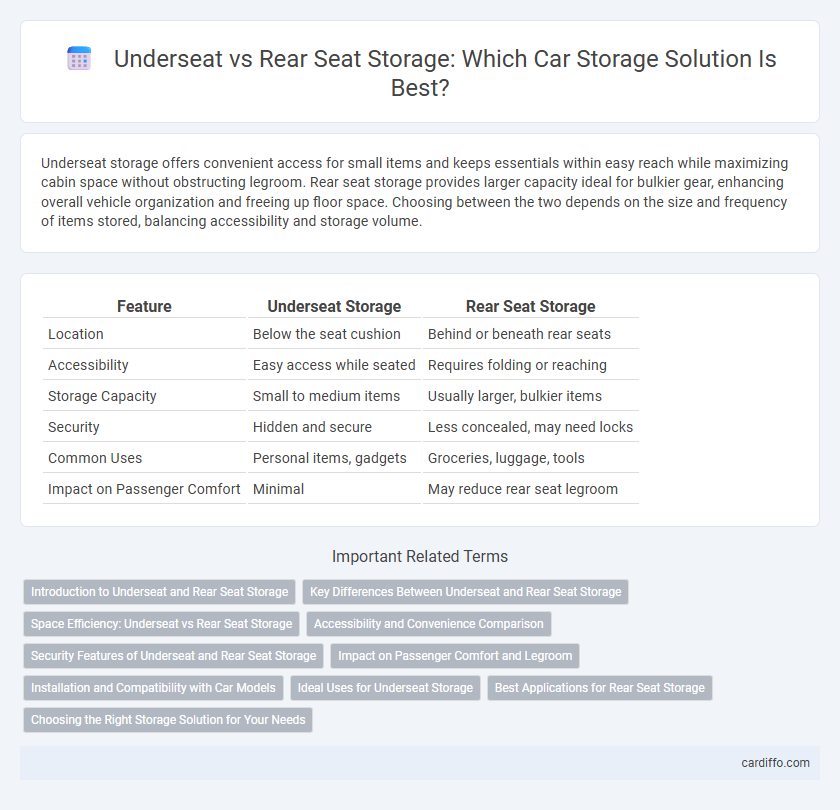Underseat storage offers convenient access for small items and keeps essentials within easy reach while maximizing cabin space without obstructing legroom. Rear seat storage provides larger capacity ideal for bulkier gear, enhancing overall vehicle organization and freeing up floor space. Choosing between the two depends on the size and frequency of items stored, balancing accessibility and storage volume.
Table of Comparison
| Feature | Underseat Storage | Rear Seat Storage |
|---|---|---|
| Location | Below the seat cushion | Behind or beneath rear seats |
| Accessibility | Easy access while seated | Requires folding or reaching |
| Storage Capacity | Small to medium items | Usually larger, bulkier items |
| Security | Hidden and secure | Less concealed, may need locks |
| Common Uses | Personal items, gadgets | Groceries, luggage, tools |
| Impact on Passenger Comfort | Minimal | May reduce rear seat legroom |
Introduction to Underseat and Rear Seat Storage
Underseat storage offers a compact, easily accessible space beneath the front seats, ideal for keeping small items organized and out of sight. Rear seat storage provides a larger capacity area behind the rear seats, suitable for storing bulkier items such as luggage or sports equipment. Choosing between underseat and rear seat storage depends on the vehicle type and storage needs, balancing convenience and volume.
Key Differences Between Underseat and Rear Seat Storage
Underseat storage offers compact, easily accessible compartments ideal for small items and quick retrieval, enhancing convenience during travel. Rear seat storage provides larger capacity space suitable for bulkier items or multiple belongings, delivering more extensive organization options in vehicles. Key differences include size, accessibility, and usage flexibility, impacting the choice based on storage needs and vehicle design.
Space Efficiency: Underseat vs Rear Seat Storage
Underseat storage maximizes space efficiency by utilizing typically unused areas beneath the seat, allowing for compact and hidden storage solutions ideal for small items and valuables. Rear seat storage offers larger capacity but can reduce passenger legroom and accessibility, making it more suitable for bulkier items or long-term storage needs. Choosing between underseat and rear seat storage depends on balancing space availability with convenience and item size requirements.
Accessibility and Convenience Comparison
Underseat storage offers easier accessibility by placing items within arm's reach without requiring passengers to shift or move significantly, enhancing convenience for frequently used belongings. Rear seat storage, while providing larger capacity, often involves more effort to access, especially when items are stored under or behind the seats, reducing quick retrieval efficiency. Prioritizing accessibility, underseat compartments are ideal for daily essentials, whereas rear seat storage suits bulkier items that are accessed less frequently.
Security Features of Underseat and Rear Seat Storage
Underseat storage offers enhanced security with concealed compartments that reduce visibility and deter theft, often featuring lockable options for added protection. Rear seat storage typically provides larger capacity but may lack the discreetness and secure locking mechanisms found in underseat compartments. Advanced security features in underseat storage include tamper-resistant designs and integration with vehicle alarm systems, improving overall cargo safety.
Impact on Passenger Comfort and Legroom
Underseat storage maximizes passenger comfort by preserving legroom and allowing easy access without requiring rear passengers to adjust their seating position. Rear seat storage often reduces available legroom, leading to cramped conditions and discomfort during long trips. Efficient underseat compartments enhance overall cabin space utilization without compromising passenger mobility or comfort.
Installation and Compatibility with Car Models
Underseat storage systems offer a compact installation that fits seamlessly beneath the front seats, making them compatible primarily with vehicles that have sufficient clearance and a flat floor design. Rear seat storage solutions often require attachment to the back of seats or the rear cabin area, supporting a wider range of car models including SUVs, sedans, and trucks due to more flexible mounting options. Compatibility depends heavily on vehicle make, model year, and interior layout, with many manufacturers providing model-specific kits for both underseat and rear seat storage installations.
Ideal Uses for Underseat Storage
Underseat storage is ideal for keeping frequently used items like personal electronics, small tools, or emergency supplies easily accessible during travel. This storage solution maximizes cabin space by utilizing areas directly beneath the seats, making it perfect for compact vehicles or those seeking clutter reduction. Unlike rear seat storage, underseat compartments offer quick access without the need to leave the driver's seat, enhancing convenience and safety.
Best Applications for Rear Seat Storage
Rear seat storage offers optimal space for larger, less frequently accessed items such as emergency kits, backpacks, or groceries, making it ideal for families and long trips. Its location facilitates easy access without cluttering the main cabin, enhancing passenger comfort and safety. Vehicles with rear seat storage often provide secure compartments that help organize belongings while maximizing available interior space.
Choosing the Right Storage Solution for Your Needs
Underseat storage offers easy access and discreet space for smaller items, making it ideal for frequently used essentials and maximizing cabin organization. Rear seat storage provides larger capacity suitable for bulkier items or additional luggage, perfect for long trips or transporting sports equipment. Evaluating your daily cargo needs and vehicle layout ensures the optimal choice between convenience and volume when selecting the best storage solution.
underseat storage vs rear seat storage Infographic

 cardiffo.com
cardiffo.com